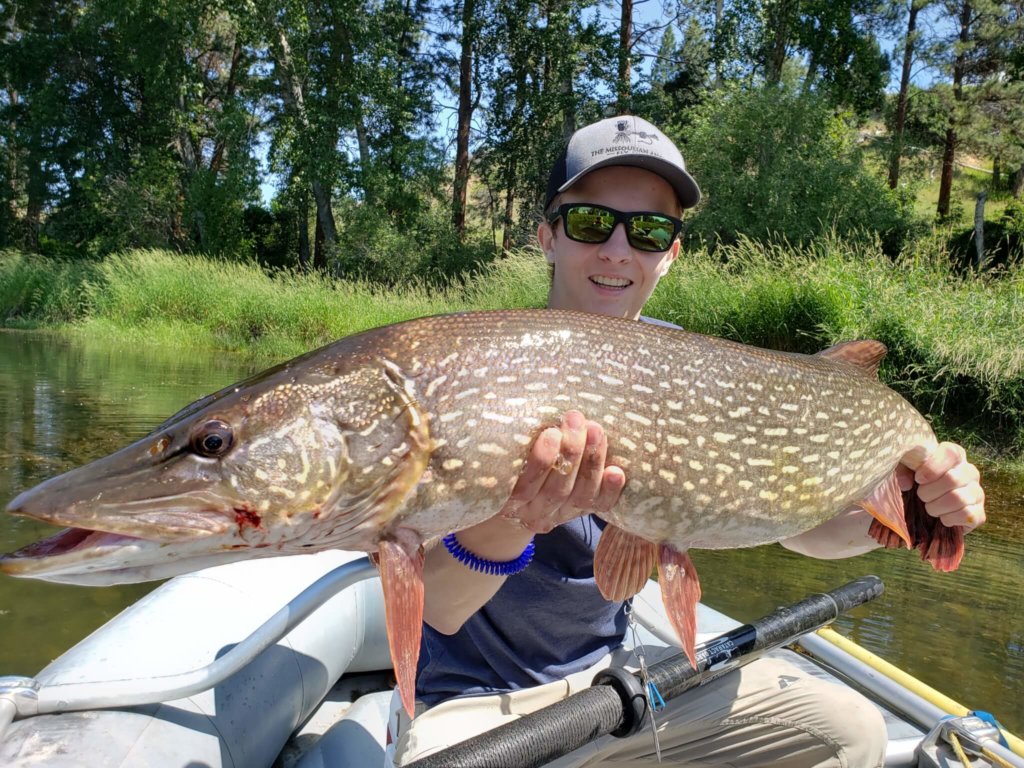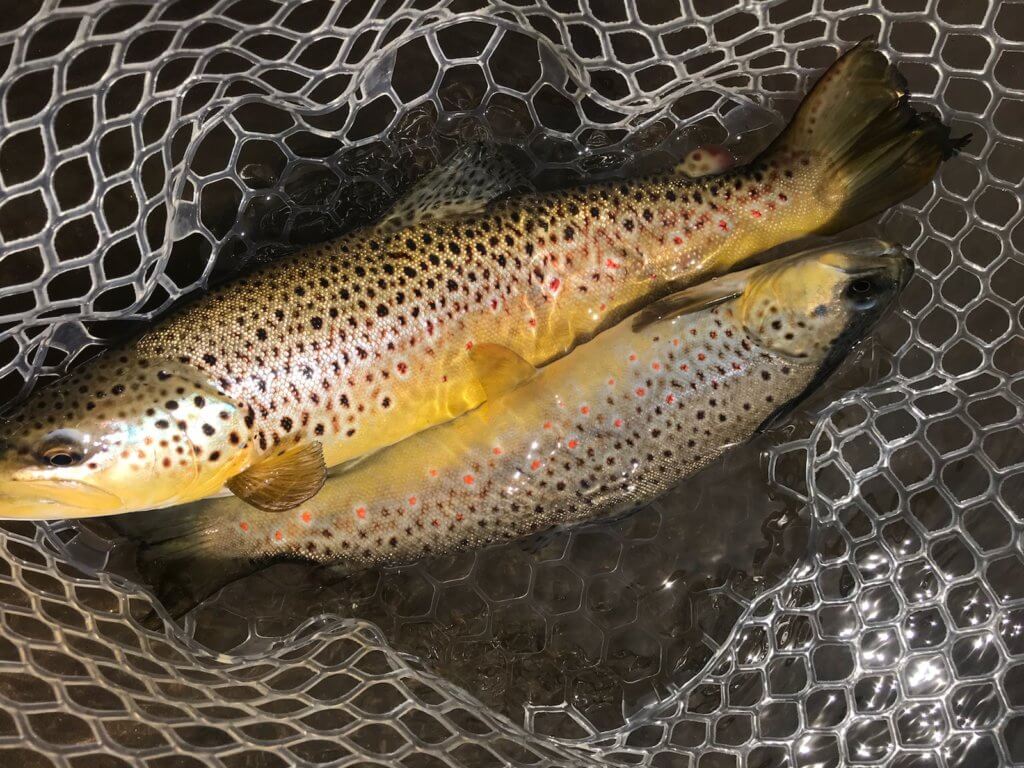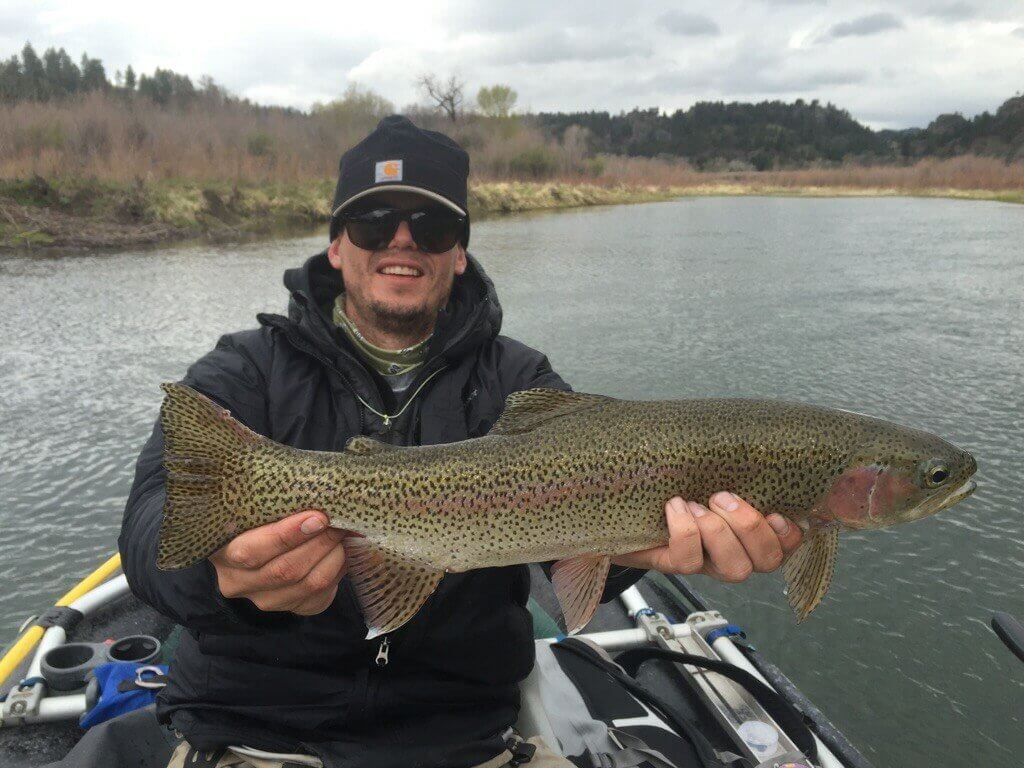What Size Streamers For A 4 Wt.
thirteen Tips for Wing Line-fishing Streamers

-Tip #1 Rod Tip Low
Keep your rod tip low. Keep your rod tip pointed at the fly. Read that over again! The biggest and most common mistake we see when fly fishing streamers in Montana is retrieving the streamer with the rod tip to the side or in the air similar a spinning rod. Both these techniques create slack in your line, and so y'all tin't feel the take. A piffling twitch to the side is okay to activate the streamer, then correct back to pointing the rod tip directly at the streamer with a strip to insure your line stays tight. We oft say point your rod tip straight at the streamer with the tip of the rod in the water. Shake the rod side to side for action- never pull upwards or back. You create slack, and lose power on the hook set.
-Tip #2 Alter Colors
If you've ever been to our wing shop in Missoula, MT, you'll come across we have i of the largest, if not the largest streamer selections in Montana. In every size and colour. More of import than mode or pattern is size and color. If you're confident in the water yous're fishing and nothing seems to be eating your streamer, then switch colors until you find 1 they'll consume. If you ask ten streamer fishermen, you'll probably get x different answers when it comes to streamer color. Many of our guides switch colors every 15 minutes until we find ane the trout are interested in that day. Could take 5-six tries! Again, lots of theories, but conventional wisdom states start lite, like white, and progressively change to darker flies. Start with white, go to tan, then light olive to night olive to brown to black is a not bad strategy to utilise. In our stance, this holds true regardless of lighting weather.
-Tip #3 Switch Up Your Call up
Merely like switching colors, information technology's also a skillful thought to change your retrieve. Some days the trout want it stripped irksome, other days they want a fast-moving streamer and some days they desire a lot of action with twitches and fast bursts. During the day of fishing, switch up your retrieve until the trout tells yous how they want it. Water temperature has a lot to do with how you think your streamer- check out Tip # eight.
-Tip #iv Strip Gear up
Trout tin exist very aggressive when chasing smaller fish, which is what yous're imitating with a streamer. Often fish will slash multiple times at your streamer without actually eating it. It'south so difficult to leave the streamer in the water, only that's what the strip fix does. A strip set ways setting the hook with a large strip of line backwards, rather than the traditional trout set which lifts the tip high to a higher place your head. Because the strip set doesn't lift the rod and jerk the fly out of range, the fish can come back to eat again and once more. When fish are slashing first, and eating on the 2d or third shot, the strip set keeps you in the game a lot longer.
-Tip #5 Size Down
Big flies take big fish. That'south the mantra. Many Missoula anglers get defenseless up in that mindset, proverb you lot must fish big streamers to take hold of large fish. While that statement is true, some of the biggest trout we've taken in Montana have eaten pocket-size streamers. Big articulated streamers can be fun to throw and you tin can grab some giant trout on them, simply they're tough to cast and not always necessary. Many anglers, peculiarly waders, but carry ane rod. Size your fly to the line weight you lot have. If you lot want to fish streamers but only deport one rod, our advice is carry a 6wt that easily throws a dry/dropper or nymph rig if the streamer angling isn't productive. A smaller streamer is easier to cast, which improves accuracy. Big fish live where they live- if you become the streamer to them, big or small, there's a skilful gamble they will eat.

-Tip #6 Match Fly Sink Rate To Fly Line
We meet many Montana fly fishermen throwing neutrally buoyant or floating streamers on a floating line. They often come in and ask if they should be using divide shot when fishing this fly. The answer is, yous're going to demand something to sink that fly! Please annotation certain streamers are designed to exist fished on a sink tip while others are designed to fish on a floating fly line. The more buoyant streamers, those with deer pilus heads or lots of bulk, should exist fished on a sink tip. The fly line goes deeper while the streamer suspends up off the bottom, a very enticing action. Heavily weighted streamers, using beads, lead or coneheads, perform better on floating lines because they sink speedily. If you fish those heavy streamers on a sinking line, they will tend to snag upwardly every bit the line and heavy fly gets too deep.
-Tip #7 Lengthen Leader As Water Clears
June fly angling effectually Missoula often involves water that'south a bit loftier and off colored. In these conditions, the fish are not line or leader shy. A simple leader made of four-six feet of heavy tippet, similar Maxima 15- 20 lb, is ideal. Equally the water drops and clears, yous'll demand to size downwardly and taper your leader. Trout see better in depression, clear h2o conditions and will spot your rig more easily when fishing a heavy short leader. Extending you leader to 9-12 feet, tapering down to 3x (don't be afraid to use fluorocarbon leader), volition increase your strikes in articulate conditions. Think stealth!
-Tip #eight Pay attention to Water Temperatures
H2o temperatures play a huge function in how trout react to your streamers around Missoula and throughout Montana. Very common cold water (33-45 degrees) and warmer h2o (60 degrees and above) will slow fish down, and they won't chase a streamer as aggressively equally when the water is between 45 and threescore degrees. During wintertime and early spring, the water is typically too common cold for a trout to aggressively chase a streamer, and same said for the warm temps we sometimes meet in August. During these conditions yous demand to fish your streamers slow- either expressionless drifting, slowly stripping or swinging your streamer. The sweet spot is from 45-sixty degrees. This is when yous tin can brainstorm to be a little more active with your retrieve, moving it faster through the water with a lot of action. But remember, trout are trout. Sometimes trout will slam stripped streamers in colder or warmer weather, or demand a dead drift in the optimum temperature range. While this is an excellent jumping off point, always listen to what the trout are trying to tell you. Vary your tactics till the fish start eating.
-Tip #nine High Water Means Tight To The Banks
During high water in Montana, the fish volition exist pushed close to the bank to the only soft h2o in the river. This tip is more for floaters, just helps all anglers notice fish in these conditions. When fishing loftier water, bang the banks and stay there. Cast as close to shore every bit possible. Strip the wing about 6-seven feet off the bank, then pick upwardly and do it again. Since the fish are pushed to the edges of the river it's oft pointless to strip more than than 5 feet from the bank, as fish don't like to venture into heavier water. This technique has you delivering more flies where fish are hanging, and ignoring unproductive water. As the water drops, your retrieves volition lengthen, every bit fish motility from the banks to their summer property water

-Tip #ten Strip All the Way In
Guides see it all the fourth dimension. Guests strip their streamer about halfway to the gunkhole, and when starting the adjacent bandage, a trout charges the streamer but it's gone. Other than high water conditions (run across Tip #9), it's wise to retrieve your streamer all the mode to the boat if floating, or to the bank if wading. Fish ofttimes follow a streamer for a distance earlier eating, and fishing out your cast will add some fish to your count. Every bit an added bonus, it's awesome to watch a huge trout trounce your wing 10 feet from the tip of the rod. Ane final thought. If a trout charges your fly as you starting time the dorsum cast, they might be telling y'all to move the fly faster during your retrieve. Only saying…….
-Tip #11 Skinny Patterns
Big flies catch big fish, only in that location is a limit! Call back almost it, how many baitfish in Montana rivers are 5 inches long and ii inches wide or iv inches long and 2 inch wide? Non many species in Montana rivers fit that profile and neither should your streamers. There are many streamers on the market that are also bulky to be effective. When these huge streamers were introduced, they took some fish, only every bit the fish meet more and more, their effectiveness is dwindling. Now information technology seems similar fish are more willing to swallow smaller thinner flies that correspond the baitfish they naturally see in Montana. These thinner profile flies are what we typically become the nearly activity on.
-Tip #12 Swing It
In that location are three principal methods to presenting streamers- stripping, expressionless drift and swinging. Swinging is oftentimes disregarded, yet can be one of the most productive ways to take hold of trout. Instead of stripping your fly toward y'all, try casting your streamer direct across the river, or quartered downstream and hold on tight. Permit the streamer to swing through your called water and straighten out below you. It's a skillful thought to twitch or shake the rod tip to give your fly a little movement. This strategy covers a lot of water effectively and often times will put the fly suspended in front of the fishes face for a longer menstruum then stripping it beyond.
-Tip #13 Night Angling
If you read our Mouse angling page, yous know nosotros honey nighttime fishing with rodents. The large slash, the crushing rise, Mousing is just an exciting, fun way to fish! It's piece of cake to overlook streamer fishing at nighttime. It's simple math. How many mice are in the water? How many fish are in the h2o? In that location's more piddling fish than mice, so trout are more attuned to taking a streamer. Night fourth dimension is when the big Chocolate-brown Trout come out to feed, and a well presented streamer volition take these fish with more regularity than a floating imitation. We typically fish black streamer patterns creating a strong silhouette during the darkest nights. If the moon is full and brilliant, then flashy patterns can produce, but black makes a great silhouette at dark and has been our most productive. Focus on shallow h2o and inside bends every bit nocturnal fish hunt their prey in these areas.
Additional Streamer Resources
What Size Streamers For A 4 Wt.,
Source: https://www.missoulianangler.com/13-tips-for-fly-fishing-streamers/
Posted by: bateshipleoped.blogspot.com


0 Response to "What Size Streamers For A 4 Wt."
Post a Comment